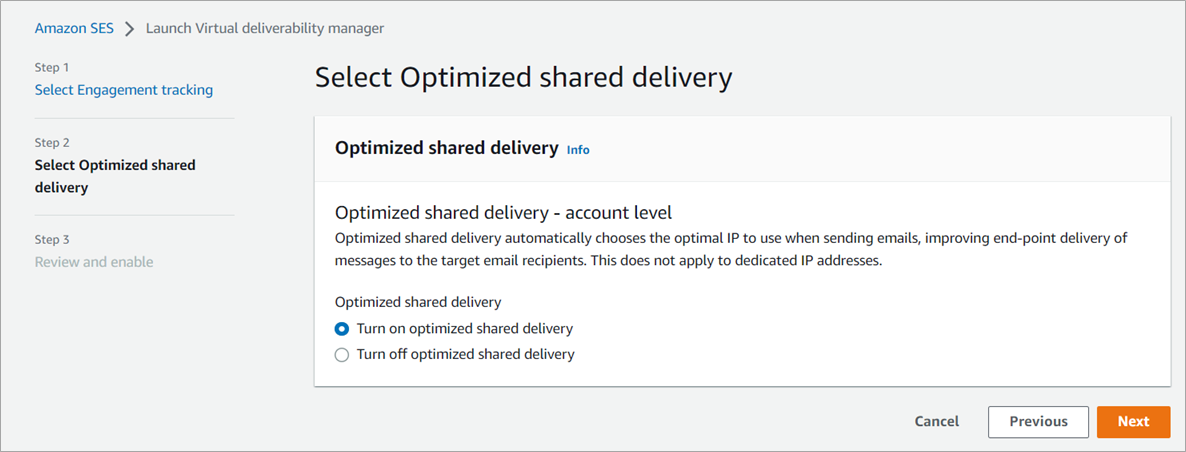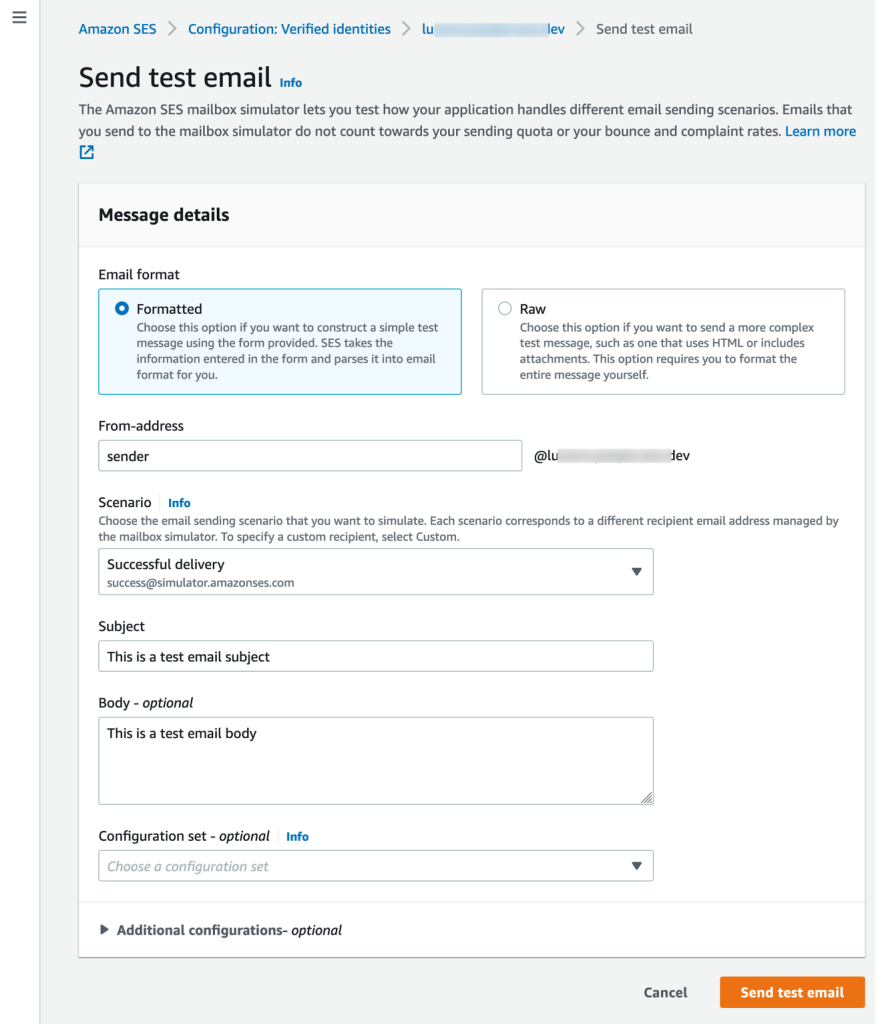Post Syndicated from Pavlos Ioannou Katidis original https://aws.amazon.com/blogs/messaging-and-targeting/use-machine-learning-to-target-your-customers-based-on-their-interest-in-a-product-or-product-attribute/
Customer segmentation allows marketers to better tailor their efforts to specific subgroups of their audience. Businesses who employ customer segmentation can create and communicate targeted marketing messages that resonate with specific customer groups. Segmentation increases the likelihood that customers will engage with the brand, and reduces the potential for communications fatigue—that is, the disengagement of customers who feel like they’re receiving too many messages that don’t apply to them. For example, if your business wants to launch an email campaign about business suits, the target audience should only include people who wear suits.
This blog presents a solution that uses Amazon Personalize to generate highly personalized Amazon Pinpoint customer segments. Using Amazon Pinpoint, you can send messages to those customer segments via campaigns and journeys.
Personalizing Pinpoint segments
Marketers first need to understand their customers by collecting customer data such as key characteristics, transactional data, and behavioral data. This data helps to form buyer personas, understand how they spend their money, and what type of information they’re interested in receiving.
You can create two types of customer segments in Amazon Pinpoint: imported and dynamic. With both types of segments, you need to perform customer data analysis and identify behavioral patterns. After you identify the segment characteristics, you can build a dynamic segment that includes the appropriate criteria. You can learn more about dynamic and imported segments in the Amazon Pinpoint User Guide.
Businesses selling their products and services online could benefit from segments based on known customer preferences, such as product category, color, or delivery options. Marketers who want to promote a new product or inform customers about a sale on a product category can use these segments to launch Amazon Pinpoint campaigns and journeys, increasing the probability that customers will complete a purchase.
Building targeted segments requires you to obtain historical customer transactional data, and then invest time and resources to analyze it. This is where the use of machine learning can save time and improve the accuracy.
Amazon Personalize is a fully managed machine learning service, which requires no prior ML knowledge to operate. It offers ready to use models for segment creation as well as product recommendations, called recipes. Using Amazon Personalize USER_SEGMENTATION recipes, you can generate segments based on a product ID or a product attribute.
About this solution
The solution is based on the following reference architectures:
Both of these architectures are deployed as nested stacks along the main application to showcase how contextual segmentation can be implemented by integrating Amazon Personalize with Amazon Pinpoint.
High level architecture

Once training data and training configuration are uploaded to the Personalize data bucket (1) an AWS Step Function state machine is executed (2). This state machine implements a training workflow to provision all required resources within Amazon Personalize. It trains a recommendation model (3a) based on the Item-Attribute-Affinity recipe. Once the solution is created, the workflow creates a batch segment job to get user segments (3b). The job configuration focuses on providing segments of users that are interested in action genre movies
{ "itemAttributes": "ITEMS.genres = \"Action\"" }
When the batch segment job finishes, the result is uploaded to Amazon S3 (3c). The training workflow state machine publishes Amazon Personalize state changes on a custom event bus (4). An Amazon Event Bridge rule listens on events describing that a batch segment job has finished (5). Once this event is put on the event bus, a batch segment postprocessing workflow is executed as AWS Step Function state machine (6). This workflow reads and transforms the segment job output from Amazon Personalize (7) into a CSV file that can be imported as static segment into Amazon Pinpoint (8). The CSV file contains only the Amazon Pinpoint endpoint-ids that refer to the corresponding users from the Amazon Personalize recommendation segment, in the following format:
Id
hcbmnng30rbzf7wiqn48zhzzcu4
tujqyruqu2pdfqgmcgkv4ux7qlu
keul5pov8xggc0nh9sxorldmlxc
lcuxhxpqh/ytkitku2zynrqb2ce
The mechanism to resolve an Amazon Pinpoint endpoint id relies on the user id that is set in Amazon Personalize to be also referenced in each endpoint within Amazon Pinpoint using the user ID attribute.

The workflow ensures that the segment file has a unique filename so that the segments within Amazon Pinpoint can be identified independently. Once the segment CSV file is uploaded to S3 (7), the segment import workflow creates a new imported segment within Amazon Pinpoint (8).
Datasets
The solution uses an artificially generated movies’ dataset called Bingewatch for demonstration purposes. The data is pre-processed to make it usable in the context of Amazon Personalize and Amazon Pinpoint. The pre-processed data consists of the following:
- Interactions’ metadata created out of the Bingewatch ratings.csv
- Items’ metadata created out of the Bingewatch movies.csv
- users’ metadata created out of the Bingewatch ratings.csv, enriched with invented data about e-mail address and age
- Amazon Pinpoint endpoint data
Interactions’ dataset
The interaction dataset describes movie ratings from Bingewatch users. Each row describes a single rating by a user identified by a user id.
The EVENT_VALUE describes the actual rating from 1.0 to 5.0 and the EVENT_TYPE specifies that the rating resulted because a user watched this movie at the given TIMESTAMP, as shown in the following example:
USER_ID,ITEM_ID,EVENT_VALUE,EVENT_TYPE,TIMESTAMP
1,1,4.0,Watch,964982703
2,3,4.0,Watch,964981247
3,6,4.0,Watch,964982224
...
Items’ dataset
The item dataset describes each available movie using a TITLE, RELEASE_YEAR, CREATION_TIMESTAMP and a pipe concatenated list of GENRES, as shown in the following example:
ITEM_ID,TITLE,RELEASE_YEAR,CREATION_TIMESTAMP,GENRES
1,Toy Story,1995,788918400,Adventure|Animation|Children|Comedy|Fantasy
2,Jumanji,1995,788918400,Adventure|Children|Fantasy
3,Grumpier Old Men,1995,788918400,Comedy|Romance
...
Users’ dataset
The users dataset contains all known users identified by a USER_ID. This dataset contains artificially generated metadata that describe the users’ GENDER and AGE, as shown in the following example:
USER_ID,GENDER,E_MAIL,AGE
1,Female,[email protected],21
2,Female,[email protected],35
3,Male,[email protected],37
4,Female,[email protected],47
5,Agender,[email protected],50
...
Amazon Pinpoint endpoints
To map Amazon Pinpoint endpoints to users in Amazon Personalize, it is important to have a consisted user identifier. The mechanism to resolve an Amazon Pinpoint endpoint id relies that the user id in Amazon Personalize is also referenced in each endpoint within Amazon Pinpoint using the userId attribute, as shown in the following example:
User.UserId,ChannelType,User.UserAttributes.Gender,Address,User.UserAttributes.Age
1,EMAIL,Female,[email protected],21
2,EMAIL,Female,[email protected],35
3,EMAIL,Male,[email protected],37
4,EMAIL,Female,[email protected],47
5,EMAIL,Agender,[email protected],50
...
Solution implementation
Prerequisites
To deploy this solution, you must have the following:
Note: This solution creates an Amazon Pinpoint project with the name personalize. If you want to deploy this solution on an existing Amazon Pinpoint project, you will need to perform changes in the YAML template.
Deploy the solution
Step 1: Deploy the SAM solution
Clone the GitHub repository to your local machine (how to clone a GitHub repository). Navigate to the GitHub repository location in your local machine using SAM CLI and execute the command below:
sam deploy --stack-name contextual-targeting --guided
Fill the fields below as displayed. Change the AWS Region to the AWS Region of your preference, where Amazon Pinpoint and Amazon Personalize are available. The Parameter Email is used from Amazon Simple Notification Service (SNS) to send you an email notification when the Amazon Personalize job is completed.
Configuring SAM deploy
======================
Looking for config file [samconfig.toml] : Not found
Setting default arguments for 'sam deploy' =========================================
Stack Name [sam-app]: contextual-targeting
AWS Region [us-east-1]: eu-west-1
Parameter Email []: [email protected]
Parameter PEVersion [v1.2.0]:
Parameter SegmentImportPrefix [pinpoint/]:
#Shows you resources changes to be deployed and require a 'Y' to initiate deploy
Confirm changes before deploy [y/N]:
#SAM needs permission to be able to create roles to connect to the resources in your template
Allow SAM CLI IAM role creation [Y/n]:
#Preserves the state of previously provisioned resources when an operation fails
Disable rollback [y/N]:
Save arguments to configuration file [Y/n]:
SAM configuration file [samconfig.toml]:
SAM configuration environment [default]:
Looking for resources needed for deployment:
Creating the required resources...
[...]
Successfully created/updated stack - contextual-targeting in eu-west-1
======================
Step 2: Import the initial segment to Amazon Pinpoint
We will import some initial and artificially generated endpoints into Amazon Pinpoint.
Execute the command below to your AWS CLI in your local machine.
The command below is compatible with Linux:
SEGMENT_IMPORT_BUCKET=$(aws cloudformation describe-stacks --stack-name contextual-targeting --query 'Stacks[0].Outputs[?OutputKey==`SegmentImportBucket`].OutputValue' --output text)
aws s3 sync ./data/pinpoint s3://$SEGMENT_IMPORT_BUCKET/pinpoint
For Windows PowerShell use the command below:
$SEGMENT_IMPORT_BUCKET = (aws cloudformation describe-stacks --stack-name contextual-targeting --query 'Stacks[0].Outputs[?OutputKey==`SegmentImportBucket`].OutputValue' --output text)
aws s3 sync ./data/pinpoint s3://$SEGMENT_IMPORT_BUCKET/pinpoint
Step 3: Upload training data and configuration for Amazon Personalize
Now we are ready to train our initial recommendation model. This solution provides you with dummy training data as well as a training and inference configuration, which needs to be uploaded into the Amazon Personalize S3 bucket. Training the model can take between 45 and 60 minutes.
Execute the command below to your AWS CLI in your local machine.
The command below is compatible with Linux:
PERSONALIZE_BUCKET=$(aws cloudformation describe-stacks --stack-name contextual-targeting --query 'Stacks[0].Outputs[?OutputKey==`PersonalizeBucketName`].OutputValue' --output text)
aws s3 sync ./data/personalize s3://$PERSONALIZE_BUCKET
For Windows PowerShell use the command below:
$PERSONALIZE_BUCKET = (aws cloudformation describe-stacks --stack-name contextual-targeting --query 'Stacks[0].Outputs[?OutputKey==`PersonalizeBucketName`].OutputValue' --output text)
aws s3 sync ./data/personalize s3://$PERSONALIZE_BUCKET
Step 4: Review the inferred segments from Amazon Personalize
Once the training workflow is completed, you should receive an email on the email address you provided when deploying the stack. The email should look like the one in the screenshot below:

Navigate to the Amazon Pinpoint Console > Your Project > Segments and you should see two imported segments. One named endpoints.csv that contains all imported endpoints from Step 2. And then a segment named ITEMSgenresAction_<date>-<time>.csv that contains the ids of endpoints that are interested in action movies inferred by Amazon Personalize

You can engage with Amazon Pinpoint customer segments via Campaigns and Journeys. For more information on how to create and execute Amazon Pinpoint Campaigns and Journeys visit the workshop Building Customer Experiences with Amazon Pinpoint.
Next steps
Contextual targeting is not bound to a single channel, like in this solution email. You can extend the batch-segmentation-postprocessing workflow to fit your engagement and targeting requirements.
For example, you could implement several branches based on the referenced endpoint channel types and create Amazon Pinpoint customer segments that can be engaged via Push Notifications, SMS, Voice Outbound and In-App.
Clean-up
To delete the solution, run the following command in the AWS CLI.
The command below is compatible with Linux:
SEGMENT_IMPORT_BUCKET=$(aws cloudformation describe-stacks --stack-name contextual-targeting --query 'Stacks[0].Outputs[?OutputKey==`SegmentImportBucket`].OutputValue' --output text)
PERSONALIZE_BUCKET=$(aws cloudformation describe-stacks --stack-name contextual-targeting --query 'Stacks[0].Outputs[?OutputKey==`PersonalizeBucketName`].OutputValue' --output text)
aws s3 rm s3://$SEGMENT_IMPORT_BUCKET/ --recursive
aws s3 rm s3://$PERSONALIZE_BUCKET/ --recursive
sam delete
For Windows PowerShell use the command below:
$SEGMENT_IMPORT_BUCKET=$(aws cloudformation describe-stacks --stack-name contextual-targeting --query 'Stacks[0].Outputs[?OutputKey==`SegmentImportBucket`].OutputValue' --output text)
$PERSONALIZE_BUCKET=$(aws cloudformation describe-stacks --stack-name contextual-targeting --query 'Stacks[0].Outputs[?OutputKey==`PersonalizeBucketName`].OutputValue' --output text)
aws s3 rm s3://$SEGMENT_IMPORT_BUCKET/ --recursive
aws s3 rm s3://$PERSONALIZE_BUCKET/ --recursive
sam delete
Amazon Personalize resources like Dataset groups, datasets, etc. are not created via AWS Cloudformation, thus you have to delete them manually. Please follow the instructions in the official AWS documentation on how to clean up the created resources.
About the Authors
Pavlos Ioannou Katidis
Pavlos Ioannou Katidis is an Amazon Pinpoint and Amazon Simple Email Service Specialist Solutions Architect at AWS. He loves to dive deep into his customer’s technical issues and help them design communication solutions. In his spare time, he enjoys playing tennis, watching crime TV series, playing FPS PC games, and coding personal projects.
Christian Bonzelet
Christian Bonzelet is an AWS Solutions Architect at DFL Digital Sports. He loves those challenges to provide high scalable systems for millions of users. And to collaborate with lots of people to design systems in front of a whiteboard. He uses AWS since 2013 where he built a voting system for a big live TV show in Germany. Since then, he became a big fan on cloud, AWS and domain driven design.















 Applying new deliverability features is simple in the AWS console. Senders can log into their SES account dashboard to enable the virtual deliverability manager features. The features are billed as monthly subscription and can be turned on or off at any time. Once the features are activated, SES provides deliverability insights and recommendations in real time, allowing senders to improve performance of future sending batches or campaigns. Senders using Simple Email Service (SES) get reliable, scalable email at the lowest industry prices. SES is backed by AWS’ data security, and email through SES supports compliance with HIPAA-eligible, FedRAMP-, GDPR-, and ISO-certified options.
Applying new deliverability features is simple in the AWS console. Senders can log into their SES account dashboard to enable the virtual deliverability manager features. The features are billed as monthly subscription and can be turned on or off at any time. Once the features are activated, SES provides deliverability insights and recommendations in real time, allowing senders to improve performance of future sending batches or campaigns. Senders using Simple Email Service (SES) get reliable, scalable email at the lowest industry prices. SES is backed by AWS’ data security, and email through SES supports compliance with HIPAA-eligible, FedRAMP-, GDPR-, and ISO-certified options.




 Do not delete unsent messages from the queues. These messages will become visible after their queue’s visibility timeout is reached.
Do not delete unsent messages from the queues. These messages will become visible after their queue’s visibility timeout is reached.














































 Satyasovan Tripathy works as a Senior Specialist Solution Architect at AWS. He is situated in Bengaluru, India, and focuses on the AWS Digital User Engagement product portfolio. He enjoys reading and travelling outside of work.
Satyasovan Tripathy works as a Senior Specialist Solution Architect at AWS. He is situated in Bengaluru, India, and focuses on the AWS Digital User Engagement product portfolio. He enjoys reading and travelling outside of work. Nikhil Khokhar is a Solutions Architect at AWS. He specializes in building and supporting data streaming solutions that help customers analyze and get value out of their data. In his free time, he makes use of his 3D printing skills to solve everyday problems.
Nikhil Khokhar is a Solutions Architect at AWS. He specializes in building and supporting data streaming solutions that help customers analyze and get value out of their data. In his free time, he makes use of his 3D printing skills to solve everyday problems.











![[VIDEO] An Inside Look at AWS re:Inforce 2022 From the Rapid7 Team](https://blog.rapid7.com/content/images/2022/07/aws-experience-video.jpg)
![[VIDEO] An Inside Look at AWS re:Inforce 2022 From the Rapid7 Team](https://play.vidyard.com/6hfyFPDQMUmPuNW4fARLWD.jpg)
![[VIDEO] An Inside Look at AWS re:Inforce 2022 From the Rapid7 Team](https://play.vidyard.com/UH5i67HA1cChhyxVQy8Uku.jpg)
